Rome After Raphael
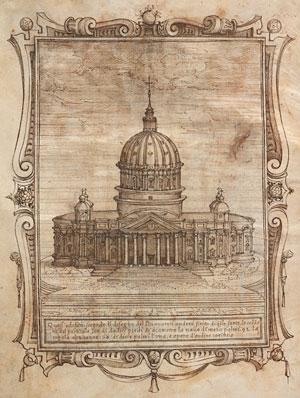
In the early 1500s, Rome's majesty was a distant memory: its marble temples and palaces had been ransacked; its population was a fraction of what it had been in antiquity. Yet, over the course of the next hundred years, the Eternal City would experience an amazing rebirth, as a series of popes rebuilt and revitalized Rome and its population doubled. At the center of this metamorphosis was an unprecedented influx of artistic talent and creative exchange.
It is this remarkable period in art history that is the subject of the exhibition Rome After Raphael at The Morgan Library & Museum. Featuring more than eighty works selected almost exclusively from the Morgan's exceptional collection of Italian drawings, the exhibition brings to light the intense artistic activity in Rome from the Renaissance to the beginning of the Baroque period, approximately from 1500 to 1600.
The exhibition focuses solely on Roman Renaissance and Mannerist drawings, beginning with Raphael and ending with the dawn of a new era, the Baroque, as seen in the art of Annibale Carracci. The exhibition opens a window into the artistic sensibility and lavish patronage of the period, from Julius II—patron of both Michelangelo and Raphael and arguably the most culturally sophisticated of the popes—to his successor Leo X and the "Gran Cardinale" Alessandro Farnese and his nephew Odoardo. Cardinal Ippolito d'Este and the Medici also generated luxurious commissions as they competed to create their own legacies in chapels, palaces, and villas. Numerous drawings in the exhibition are related to Roman projects and commissions, including elaborate schemes for fresco decorations for city palaces, rural villas, and funerary chapels as well as altarpieces, tapestry designs, and views of recently discovered antiquities.
Étienne Dupérac (Paris or Bordeaux 1520–1604 Paris)
St. Peter's Basilica, Unfinished at the Time, According to Michelangelo's Design; MS M.1106
Raphael and Raphael's Followers
 Raphael
Raphael
Arriving in Rome in 1508, Raphael found success as court artist to popes Julius II della Rovere and Leo X de' Medici. The Morgan's holdings by the artist trace his development from his early pre-Roman period, represented by the fresco design Cardinal Piccolomini Presents Eleanor of Portugal to Her Betrothed, Emperor Frederick III and the cartoon related to the predella panel depicting Christ's Agony in the Garden, to his metalpoint drawing Male Figure Symbolizing an Earthquake—a study of ca. 1515 for one of the tapestries Raphael designed for the Sistine Chapel.
Raphael's Followers
Heavily employed by a succession of popes and secular patrons, Raphael developed a large workshop that included artists such as Polidoro da Caravaggio, Perino del Vaga, and Giulio Romano. After Raphael's premature death in 1520, these artists developed their own highly successful careers. Polidoro was one of the city's most prolific facade decorators, an aspect of his career uniquely illustrated by the Morgan's study of a Prisoner Brought Before a Judge, a scene once painted on a Roman house. Perino's independent career included a commission from Cardinal Alessandro Farnese for the design of rock-crystal plaques, which today still comprise part of candelabra in the treasury of St. Peter's Basilica. The Morgan's two designs for this commission, Christ Healing the Lame at the Pool of Bethesda and the Miracle of the Loaves and Fishes, are on view in the exhibition. One of Raphael's most successful pupils (and later court artist to the Gonzaga in Mantua), Giulio Romano is represented by an early lunette design and by the vigorous St. Jerome and St. Augustine. The show also includes the Codex Mellon, one of the earliest and most important volumes of Renaissance antiquarian drawings relating to contemporary architectural projects. Probably drafted ca. 1513 by an architect from the circle of the great Renaissance master Donato Bramante, the sketchbook records plans for the new basilica of St. Peter's as well as those relating to Bramante's Palazzo Caprini, also known as Raphael's house.
Raphael (Urbino 1483–1520 Rome) Male Figure Symbolizing an Earthquake, 1515–16 Metalpoint, heightened with white, on gray prepared paper Gift of Janos Scholz, 1977; 1977.45
Raphael at the Morgan
The Morgan houses a notable collection of works by the preeminent master of the High Renaissance, Raphael (Urbino 1483–1520 Rome), comprising four drawings from his hand, as well as a drawing and one painting by artists from his direct entourage.
Adoration of the Magi
 Circle of Raphael
Circle of Raphael
Adoration of the Magi, ca. 1520
Pen and brown ink, brown wash, heightened with white gouache, over faint traces of black chalk.
11 1/16 x 20 7/8 inches (281 x 530 mm)
Purchased by J. Pierpont Morgan; acc. no. IV, 29a
In addition to the Acts of the Apostles series for the Sistine Chapel, Raphael received a commission for a second set of tapestries, this one to illustrate the Life of Christ. In all likelihood, Pope Leo X Medici (reigned 1513–21) initiated this project, and most of the designs were probably completed during his papacy. Often considered the most successful of the group, the tapestry of the Adoration of the Magi, which is based on the present drawing, has the strongest claim of having been designed during Raphael's lifetime. Modern scholarship has assigned to Giovanni Francesco Penni (1496?–ca.1528) a number of finished drawings from Raphael's workshop, including, on occasion, the present study.
Agony in the Garden
 Raphael (1483–1520)
Raphael (1483–1520)
Agony in the Garden, 1503–5
Pen and brown ink, brown wash, traced with a stylus and pricked for transfer. Extensive repairs of breaks and losses.
226 x 165 mm
Watermark: None
Inscribed on verso, at lower center, in pen and brown ink, Timoteo Viti.
Purchased by J. Pierpont Morgan: acc. no. I, 15
This drawing shows the kneeling figure of Christ in prayer on the Mount of Olives just prior to his arrest and ensuing Passion, accompanied by the apostles Peter, James, and John, all of whom—despite Christ's pleas—had fallen asleep. According to the Gospel of St. Luke, an angel appeared to Christ to give him strength.
The Morgan sheet has long been connected with one of the three predella panels of Raphael's Pala Colonna, painted for Sant'Antonio di Padova in Perugia, the conventual church of cloistered Franciscan nuns.1 The conservative composition of this early altarpiece and the lyrical beauty of its figures reveal the strong influence of Pietro Perugino, with whom Raphael may have worked after initial training with his father, Giovanni Santi.2 The Agony in the Garden panel faithfully reproduces the drawing's composition, with one exception: in the preliminary study, the chalice stands on the cliffs as upon an altar; in the panel, it is held aloft by a flying angel and presented to Christ. Presumably, this late adjustment, which aligned the work with the prevailing Umbrian tradition, was occasioned by the conservative taste of the Franciscan nuns.
A typical method for transferring the design from a cartoon (a drawing done on the same scale as the finished painting) is to prick the outlines and then apply a dark chalk powder (spolvero) to the surface in order to create a pattern of holes delineating the image on the gessoed panel below. These marks are then used to guide the execution of the painting. The outlines of the Morgan drawing are indeed pricked for transfer, and the sheet is on the same scale as the predella panel. Curiously, however, and in contrast to the other two predella panels—the Pietà in the Isabella Stewart Gardner Museum, Boston, and the Procession to Calvary in the National Gallery, London—no trace of spolvero can be found on the Metropolitan Museum's panel. Possibly the paint layers are too dense for any underdrawing to appear in infrared reflectography. Interestingly, on the Morgan study there are several pricked lines that lack visible corresponding pen lines or washes beneath, probably because such indications in ink were lost over time, and indeed the drawing is in very poor condition.3
Precisely when the altarpiece and its predella were painted is a matter of some conjecture since the work is not inscribed with a date nor are there documents relating to the commission. It is generally agreed, based on style and circumstantial evidence, that the work was created between 1503 and 1505. This would place it after Raphael had left Urbino to work in Perugia and possibly make it contemporaneous with the completion of his designs for frescoes in the Piccolomini Library attached to Siena Cathedral (1502–3) and his first long sojourn in Florence, where he arrived in October 1504. Furthermore G. F. Waagen, a nineteenth-century art historian, claimed to have seen a date of 1505 on the altarpiece; however, no trace of such an inscription remains today. Interestingly, J. Pierpont Morgan—who had acquired the drawing in 1909 as part of the Fairfax Murray collection—also once owned the main panel of the altarpiece representing the Virgin and Child Enthroned with Saints, with God the Father, Angels and Cherubim.
Rhoda Eitel-Porter
1. Oil on wood, 24 x 29 cm, Inv. 1932.130.1
2. See Hugo Chapman, Tom Henry, and Carol Plazzotta, with contributions from Arnold Nesselrath and Nicholas Penny, Raphael from Urbino to Rome, exhibition catalogue, National Gallery, London, 2004, pp. 16–20, for a discussion of Raphael's early years and training.
3. Plazzotta suggested that the study may have been an auxiliary cartoon pricked through from another sheet, with the pricking lying beneath the pen-and-ink drawing (Carol Plazzotta, Raphael exhibition review, Burlington Magazine, vol.148, no.1243, October 2006, p.709). Examination in 2008 with the director of the Thaw Conservation Center at the Morgan Library & Museum, Margaret Holben Ellis, however, revealed that this does not seem to be the case; therefore the drawing surely is Raphael's original design, as has generally been thought.
Provenance:
Possibly Viti-Antaldi (according to Charles Fairfax Murray; drawing does not bear any of the Antaldi marks and cannot be identified in the Antaldi Inventory); Frederick, Lord Leighton (1830–1896), London; his sale, London, Christie's, 16 July 1896, lot 447, as Timoteo Viti "Christ in the Garden of Olives— pen and bistre" (to Murray for £20.0.0); Charles Fairfax Murray (1849–1919), London and Florence; from whom purchased through Galerie Alexandre Imbert, Rome, in 1909 by J. Pierpont Morgan (1837–1913), New York (no mark; see Lugt 1509); his son, J. P. Morgan, Jr. (1867–1943), New York.
Select Bibliography:
Charles Fairfax Murray, Collection of Drawings by the Old Masters formed by C. Fairfax Murray (J. Pierpont Morgan Collection), 4 vols., London 1905–12, vol. I, no. 15, repr.
Paul Joannides, The Drawings of Raphael. With a Complete Catalogue, Oxford, 1983, p. 152, fig. 83.
Eckhart Knab, Erwin Mitsch, and Konrad Oberhuber, Raphael: Die Zeichnungen, Stuttgart, 1983, p.59, no. 24.
Linda Wolk-Simon, Raphael at the Metropolitan Museum. The Colonna Altarpiece, (reprint of The Metropolitan Museum of Art Bulletin, spring, 2006), exhibition catalogue, Metropolitan Museum, New York, 2006, pp. 21, 69, fig. 33, no. 17;
Rhoda Eitel-Porter, in 100 Master Drawings from The Morgan Library & Museum, exhibition catalogue, Staatliche Graphische Sammlung in the Pinakothek der Moderne, Munich, 2008-2009, pp. 38-39, no. 10, repr.
Cardinal Aeneas Sylvius Piccolomini
 Raphael (1483–1520)
Raphael (1483–1520)
Cardinal Aeneas Sylvius Piccolomini Presents Eleanor of Portugal to Emperor Frederick III, 1502–4
Pen and brown ink, brown wash, heightened with white gouache (original heightening almost completely lost, later retouched), over black chalk and stylus indentations. Substantial losses and severely abraded.
559 x 421 mm (22 x 16 1/2 in.)
Inscribed, possibly by the artist, near upper edge, left of center, in pen and brown ink, Questa e la quinta [st]oria de Papa [Pio].
Bequest of Alice B. Tully; acc. no. 1996.9
This large-scale drawing is a finished compositional study, or modello, for one of the frescoes commissioned by Cardinal Francesco Todeschini Piccolomini, archbishop of Siena, from the Sienese painter Bernardino Pinturicchio (ca. 1452–1513). In a contract dated 29 June 1502, Pinturicchio agreed to decorate the walls of the library, adjacent to the north aisle of the cathedral of Siena, with a series of ten frescoes illustrating historic events from the life of Aeneas Sylvius Piccolomini, the cardinal's uncle and most distinguished member of the Piccolomini family, who had reigned as Pope Pius II from 1458 until 1464. As the inscription at the top of the drawing indicates, the sheet is a study for the fifth fresco in the cycle, which depicts the first meeting in 1452 of the Holy Roman emperor Frederick III and his betrothed, Eleanor of Portugal, outside the Porta Camollia of Siena. Between them stands Aeneas Sylvius Piccolomini, then a bishop, bestowing a blessing on the pair whose marriage he had helped to arrange during an ecclesiastical mission at the imperial court. The figures are gathered in a circle around a marble column, which was erected to commemorate the occasion and still stands to this day. The modello differs only in minor details from the fresco, which, like the rest of the cycle, was executed by Pinturicchio and his workshop. Notably, the drawing was cropped and no longer retains the lunette-shaped upper third of the composition, and it does not include the view of Siena that appears at the upper left in the finished fresco. Pinturicchio somewhat flattened the composition by enlarging the garments of many of the foreground figures and embellishing the fabrics with more decorative details.
That the experienced Pinturicchio, thirty years Raphael's senior, should avail himself of the younger master's inventions may surprise; in fact, the drawing was periodically attributed to Pinturicchio, though modern scholars generally accept Raphael's authorship. At least three additional drawings by Raphael associated with the Piccolomini project attest to his substantial involvement. Two are in the Uffizi, one of which is a compositional study in pen and ink and wash, similar in degree of finish to the present drawing. It is preparatory to the fresco The Departure of Aeneas Sylvius Piccolomini for the Council of Basel.1 The second is a loosely executed sketch for a group of riders in the same fresco.2 Another exploratory sketch in metalpoint on pale blue prepared paper in the Ashmolean Museum, Oxford,3 is a study for the group of halberdiers in the middle distance of the scene Aeneas Sylvius Piccolomini Crowned Poet Laureate.4
Raphael's contribution is also recorded by Giorgio Vasari, who in his life of the artist notes that Raphael supplied some of the preparatory studies for the Piccolimini library frescoes.5 In a second passage, Vasari goes even further. Mentioning a cartoon "still to be seen in Siena," which may possibly be identified as the present drawing, he asserts Raphael's sole responsibility for all "sketches and cartoons."6
Rhoda Eitel-Porter
1. Inv. 520 E.
2. Inv. 573E.
3. K.T. Parker, Catalogue of the Collection of Drawings in the Ashmolean Museum, 2 vols., Oxford, 1956, vol. 2, no. 510.
4. A drawing in the collection of the dukes of Devonshire at Chatsworth representing Aeneas Sylvius Piccolomini as Envoy at the Court of Eugenius IV is considered to be by an anonymous collaborator of Pinturicchio or to be a copy after Raphael. A study in the collection of Steven Juvelis, now on deposit at the Fogg Museum, Harvard University Art Museums, Cambridge, MA, is considered by some to be by Raphael, but the present author has not seen it.
5. Giorgio Vasari, ed., Everyman's Library, Lives of the Painters, Sculptors and Architects, translated by Gaston du C. De Vere with an introduction and notes by David Ekserdjian, 2 vols, 1996, vol. 1, p. 712.
6. Giorgio Vasari, ed., Everyman's Library, Lives of the Painters, Sculptors and Architects, translated by Gaston du C. De Vere with an introduction and notes by David Ekserdjian, 2 vols, 1996, vol. 1, p. 571: "Pinturicchio was summoned to Siena by Cardinal Francesco Piccolomini to paint the library made by Pope Pius II in the Duomo of that city. It is true, indeed, that the sketches and cartoons for all the scenes that he painted there were by the hand of Raffaello da Urbino, then a youth, who had been his companion and fellow-disciple under the same Pietro [Perugino], whose manner the said Raffaello had mastered very well. One of these cartoons is still to be seen at the present day in Siena."
Provenance:
Probably Francesco Piccolomini (1439–1503), Siena; probably by descent to Irene Piccolomini (1565–1593), Siena, who married Conte Tiberio Baldeschi (1542–1622) in 1586; Conte Baldeschi, Perugia, and his descendants from 1586 until at least 1915 (Panofsky records the drawing as in the Baldeschi collection in Erwin Panofsky, "Raffael und die Fresken in der Dombibliothek von Siena," Repertorium für Kunstwissenschaft, 37, 1915, pp. 269, 278–88, fig. 7); Alessandro Contini Bonacossi (1878–1955), Florence and Rome; perhaps inherited by Conte Alessandro Augusto Contini Bonacossi and his siblings; Alice Tully (1902–1993), New York.
Select Bibliography:
Giorgio Vasari, Le vite de' più eccellenti pittori, scultori ed architettori, 1568 ed., with notes by Gaetano Milanesi, 9 vols., Florence, 1878–85, vol. 3, pp. 526–27.
Erwin Panofsky, "Raffael und die Fresken in der Dombibliothek von Siena," Repertorium für Kunstwissenschaft 37, 1915, pp. 269, 278–88, fig. 7.
Rhoda Eitel-Porter, in From Leonardo to Pollock. Master Drawings From the Morgan Library, exhibition catalogue, The Morgan Library & Museum, New York, 2006, pp. 26–27, no.11, repr.
Male Figure Symbolizing an Earthquake
 Raphael (1483–1520)
Raphael (1483–1520)
Male Figure Symbolizing an Earthquake, 1515–16
Metalpoint, heightened with white, on gray prepared paper.
4 1/4 inches (108 mm; diameter)
Gift of Janos Scholz, acc. no. 1977.45
In 1515–16, Raphael, at the behest of Pope Leo X Medici, designed a series of tapestries illustrating the Acts of the Apostles; they still hang in the Sistine Chapel. Like all known studies for this series, the present drawing, which is preparatory to the scene of Saint Paul Released from Prison by an Earthquake, is in reverse orientation to the wall hanging. Possibly in response to Michelangelo's recently completed ceiling of the chapel, Raphael conceived the figure in a strongly muscular style. Its three-dimensional presence almost lifts it off the page.
Male Nude Supporting a Vessel on His Head
 Raphael (1483–1520)
Raphael (1483–1520)
Male Nude Supporting a Vessel on His Head
Pen and brown ink, over traces of metalpoint.
12 3/4 x 5 1/4 inches (323 x 132 mm)
Purchased by J. Pierpont Morgan; acc. no. I, 17
In 1504 Michelangelo's colossal statue of David was unveiled in the Piazza della Signoria, Florence, to universal acclaim and admiration. It inspired Raphael to produce a series of drawings of male nudes, such as the present one. Only one of these drawings—a study of David seen from the back, in the British Museum, London—is, essentially, a literal copy.
The male nude presented here bears a vessel in the manner of an ancient caryatid and also holds the stone with which, according to the biblical account, David slew the giant Goliath. Raphael probably created this study just prior to his departure from Florence for Rome in 1508.
The Holy Family
 Raphael Workshop
Raphael Workshop
The Holy Family
Oil on panel transferred to canvas. Cleaned in 1980.
45 1/2 x 34 3/8 inches (118.6 x 90.7 cm)
Purchased by J. Pierpont Morgan; acc. no. AZ 139
The Morgan's painting reproduces a famous composition by Raphael (1483–1520), which was probably commissioned by Pope Julius II (reigned 1503–13) and given to the church of Santa Maria del Popolo, Rome. Long considered lost, Raphael's original painting, also known as the Madonna of Loreto, likely is the one now in the Musée Condé, Chantilly. One of the numerous copies, now in Nijni Taghil, bears the date 1509, and thus possibly supplies a terminus ante quem for Raphael's original.
The composition represents the Virgin raising a transparent veil from the infant Christ, just wakened from sleep. The child reaches to play with the veil, an allusion to Christ's burial shroud and early death. The earliest published mention of Raphael's original is made by Giorgio Vasari, the celebrated sixteenth-century biographer of the Italian masters. In the 1550 edition of his Lives of the Painters, Sculptors, and Architects, he writes that Raphael painted a portrait of Pope Julius II in the same year that he also painted a very beautiful Madonna, noting that both works were preserved in the church of Santa Maria del Popolo in Rome. "In the last named picture," Vasari observes, "which represents the Nativity of Christ, the Virgin is covering with a veil the divine Child, the expression of whose countenance is of such wonderful beauty and his whole person so clearly demonstrates the divinity of his origin that all must perceive him to be truly the Son of God."
The above-mentioned portrait of Pope Julius II is probably the painting now in the National Gallery, London. It has been suggested that Pope Julius II, much distressed after his return from Bologna in 1511, donated both the Raphael portrait and Holy Family to the church of Santa Maria del Popolo, which the pope's family had patronized for several generations. Both paintings were shown to the general public only on religious feast days, when the Holy Family was displayed on one of the church's pillars.
In the Morgan version, as compared to the Chantilly original, the Virgin's brooch has gained a pendant pearl and the drapery on the bed falls in more folds. The high quality and refined detail of the Morgan version distinguish it from most of the other extant examples of this composition. In all likelihood it was made by one of Raphael's pupils during the master's lifetime or shortly after his death.
A Closer Look
What follows are the results of a noninvasive technical examination undertaken in 2009 by conservation students Jennifer Hickey and Kristin Patterson, under the guidance of Jean Dommermuth and Margaret Holben Ellis, Conservation Center, Institute of Fine Arts, New York University.
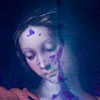 |
Ultraviolet Examination Under ultraviolet light, differences in the age and chemical composition of painting media can be detected. Ultraviolet examination analysis revealed that the painting is generally in fair condition. Significant restoration can be seen along the outer edges of the canvas and along the vertical axis. |
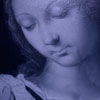 |
Infrared Reflectography Infrared reflectography, which causes layers of oil paint to appear transparent, revealed a black ink underdrawing on the painting. There is extensive underdrawing demarcating the Virgin's features and drapery, more than is found in the Chantillly version. |
 |
X-radiography X-radiography reveals differences in the densities of materials and is useful in deciphering a painting's physical construction. While the Morgan's work is, at present, on canvas, x-radiography indicated that it, like the Chantilly version, was once painted on a wood panel. The vertical striations, seen to the left, are textural remnants left in the preparatory ground (gesso) applied to the original wood panel. This ground layer, as well as the layers of oil paint found on top of it, was later transferred to canvas, a common occurrence during earlier restorations undertaken to restore deteriorated wood panels. |
 |
X-ray fluorescence X-ray fluorescence, a form of elemental analysis, can be used to identify pigments. X-ray fluorescence indicated a significant copper content in the Virgin's robe, suggesting the artist's use of azurite, a typical blue pigment employed in sixteenth-century Italian painting. |
Rhoda Eitel-Porter
Provenance:
Possibly Buonviso collection, Rome, seventeenth and eighteenth centuries (List 1 Ms. Inventory ["Inventario dei quadri dell'eredita del Signor Buonviso assegnati al sig.e Alessandro / Secolo XVI–XVII"], fol. 3, no. 70: "quadro in tavola con Gesu, Giuseppe, e Maria che con un velo cuopre il Bambino di Raffaello d'Urbino / cornice dorata." List 2 Ms. Inventory ["Quadri"], unnumbered, fourth from top: "Un Detto in tavola colla madonna, il Bamb. e S.Giuseppe di Raffaello / non lavato mai." List 3 Ms. Inventory ["Nota dei Quadri—1600–1776], fol. 7: "Quadro in Tavola bislongo, con Gesu, la Madonna, e S. Giuseppe, di Raffaello d'Urbino"; by descent to Marchese Francesco Montecatini Buonvisi, 1838 (according to Cecil Gould and Sylvie Béguin, La Madone de Lorette, exhibition catalogue, Réunion des Musées Nationaux, Paris, and Musée Condé, Chantilly, 1979, pp.18, 32, 64, no. 38); G. or W. Kennedy Laurie, Florence; Charles Fairfax Murray, London; from whom purchased through Galerie Alexandre Imbert in 1910 [invoice of March–June 1910 in Morgan Library & Museum archive, as Raphael, together with four painted portraits by Tommaso di Stefano, Nattier, Reynolds, and Largilliere, for £40,000 and delivered to Princes Gate, London].
Location:
An old photograph from the ca.1910 shows the painting at the center of the east wall in the West Room (Mr. Morgan's Study), where now hangs a painting by Cima da Conegliano.
In 1927 the painting hung near the center on the south wall of the West Room (Mr. Morgan's Study) and was no. 21 in the inventory of works loaned to the Morgan Library by J. Pierpont Morgan, Jr.
Select Bibliography:
J. A. Crowe and G.B. Cavalcaselle, Raphael: His Life and Works, London, 1882–85, pp. 110–11.
Cecil Gould and Sylvie Béguin, La Madone de Lorette, exhibition catalogue, Réunion des Musées Nationaux, Paris, and Musée Condé, Chantilly, 1979, pp.18, 32, 64, no. 38.
David Alan Brown, Raphael in America, exhibition catalogue, National Gallery of Art, Washington, 1983, pp. 33, 69–72, no. 37, fig. 14.
Michelangelo and Michelangelo's Followers
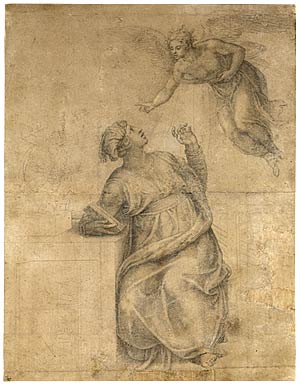 Michelangelo
Michelangelo
One of the great figures of the Renaissance whose fame has rarely been eclipsed, Michelangelo was among the forces that shaped the style usually called Mannerism. He had been summoned to Rome by Pope Julius II in 1508 to design the pope's tomb for St. Peter's, was also employed on the decoration of the Sistine ceiling and altar wall, and worked for the papacy in Rome for the last thirty years of his long and fruitful career. The Morgan's Annunciation to the Virgin of ca. 1547 and a series of four sketches of David Slaying Goliath superbly demonstrate the artist's consummate skill as a designer of dramatic compositions and draftsman of the human anatomy.
Michelangelo's Followers
Unlike Raphael, Michelangelo did not keep a large workshop, although he did have a number of associates, artist friends, and followers. Among them was Daniele da Volterra, whose Kneeling Figure of ca. 1550—a study for a fresco in the church of Santissima Trinità dei Monti—is a rare example of his delicate, precise drawing style. A drawing attributed to Giulio Clovio, that is a reprise of Michelangelo's renowned composition The Dream of Human Life (Il Sogno) of the early 1530s, reflects the fame and influence of the great master's highly refined and innovative presentation drawings. The show also includes the Farnese Hours, once the most famous illuminated manuscript, lavishly illustrated by Clovio for Cardinal Alessandro Farnese. Pellegrino Tibaldi's heavily draped Seated Barbarian Prisoners, a further example of the enduring influence of Michelangelo's figure style and draftsmanship, is also on display.
Michelangelo Buonarroti (Caprese 1475–1564 Rome) Annunciation to the Virgin Black chalk, some stumping, on paper; traced with a stylus 15 1/8 x 11 11/16 inches (383 x 297 mm) Purchased by Pierpont Morgan, 1909; IV, 7
Parmigianino and Antiquity
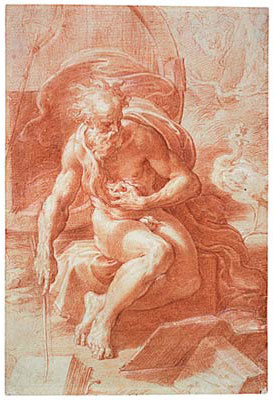 Parmigianino
Parmigianino
Supremely gifted as a painter and draftsman, Parmigianino came to Rome in 1524 seeking papal patronage but fled, as did so many of his contemporaries, when the troops of Charles V invaded the city in 1527 during the Sack of Rome. A group of five drawings from this short period are shown, including a stunning red chalk design for a print of the philosopher Diogenes, a lyrical Girl Seated on the Ground that illustrates the artist's penchant for domestic scenes, and a moving pen-and-ink Pietà freely inspired by Michelangelo's famous marble group in St. Peter's.
Antiquity
As the city was being rebuilt and reconceived under the direction of the popes, archaeological finds were commonplace, triggering a sixteenth-century fashion for antiquity that spread throughout Europe. Marble sculptures representing river gods, excavated during the 1510s and immediately put on display at the Vatican Palace, are recorded in Enea Vico's two spectacular, scrupulously detailed drawings of the early 1540s. Rome's illustrious antiquarian past informed much artistic production, as illustrated by the jewellike album on precious vellum titled The Ruins of Rome. This amusing juxtaposition of somewhat fanciful reconstructions of ancient monuments with their ruined 1570s appearance is an intriguing document of the Renaissance mind-set, bringing to life the vivid interest in reconstructing the antique.
Parmigianino (Parma 1503–1540 Casalmaggiore) Diogenes, 1524–27 Red chalk, heightened with white chalk
Late Mannerism and the Counter-Reformation
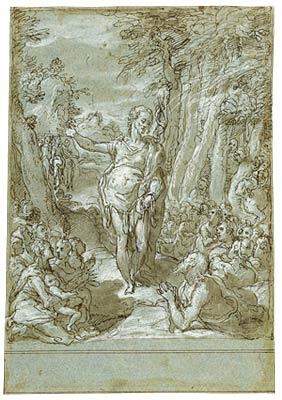 The last third of the sixteenth century saw the predominance of a highly decorative and technically masterful style generally known as Late Mannerism. This is exceptionally well represented in the Morgan collection, with outstanding examples by Taddeo and Federico Zuccaro and their followers Girolamo Muziano, Jacopo Bertoia, and Cesare Nebbia. The weightless grace of their style can be seen in Taddeo's St. John the Baptist Preaching and The Foundation of Orbetello, the latter a study for decoration of the Palazzo Farnese. Among the myriad themes that define the period is the need of the Roman Catholic Church to defend its authority against the rising threat of Protestantism. The Renaissance popes' lavish spending had led them to encourage the sale of indulgences—two are documented in the exhibition—a practice heavily criticized by Martin Luther. Eventually, the Catholic Church recognized the need for reforms and convened the Council of Trent, resulting in a movement known as the Counter-Reformation, the consequences of which became apparent in artistic production toward the end of the sixteenth century. Palestrina's mass for Pope Marcellus, the published score and recording of which are featured in the exhibition, places counter-reformatory emphasis on an easily comprehensible declamatory text.
The last third of the sixteenth century saw the predominance of a highly decorative and technically masterful style generally known as Late Mannerism. This is exceptionally well represented in the Morgan collection, with outstanding examples by Taddeo and Federico Zuccaro and their followers Girolamo Muziano, Jacopo Bertoia, and Cesare Nebbia. The weightless grace of their style can be seen in Taddeo's St. John the Baptist Preaching and The Foundation of Orbetello, the latter a study for decoration of the Palazzo Farnese. Among the myriad themes that define the period is the need of the Roman Catholic Church to defend its authority against the rising threat of Protestantism. The Renaissance popes' lavish spending had led them to encourage the sale of indulgences—two are documented in the exhibition—a practice heavily criticized by Martin Luther. Eventually, the Catholic Church recognized the need for reforms and convened the Council of Trent, resulting in a movement known as the Counter-Reformation, the consequences of which became apparent in artistic production toward the end of the sixteenth century. Palestrina's mass for Pope Marcellus, the published score and recording of which are featured in the exhibition, places counter-reformatory emphasis on an easily comprehensible declamatory text.
Taddeo Zuccaro (Sant'Angelo in Vado 1529–1566 Rome)
St. John the Baptist Preaching
Pen and brown ink, brown wash, heightened with white gouache, on blue paper; on a mount made by Giorgio Vasari
Gift of Janos Scholz, 1973; 1973.26
Annibale Carracci and the Beginning of the Baroque
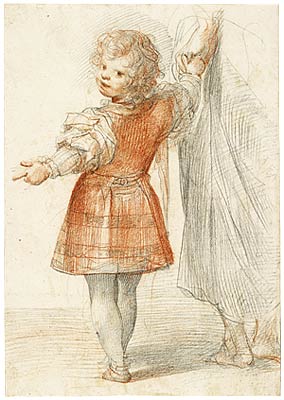 Several artists of the last decade of the sixteenth century facilitated the artistic reforms brought about by Annibale Carracci, his brother Agostino, and his cousin Ludovico. Giuseppe Cesari, called Il Cavaliere d'Arpino, is represented by the lively figure study of a Child Walking, Looking Over Its Shoulder and the striking Portrait of a Lady, both from the late 1580s. Both he and Cristofano Roncalli restricted the purely decorative Mannerist aspects of their work and reassessed High Renaissance models. They avoided spatial ambiguity in their work and strove to evoke deep religious feeling. Annibale Carracci himself paved the way for the Baroque, achieving a synthesis of Raphael's elegance and Michelangelo's drama and vigorous muscularity. Harkening back to Raphael, Annibale revived the practice of studying from the live model, as is amply obvious in his luminous Flying Putto of the late 1590s, which exhibits an astonishing command of the figure rendered in space. In addition, a new emphasis on an idealized yet naturalistic depiction of landscape is apparent in his magnificent Eroded Riverbank with Trees and Roots.
Several artists of the last decade of the sixteenth century facilitated the artistic reforms brought about by Annibale Carracci, his brother Agostino, and his cousin Ludovico. Giuseppe Cesari, called Il Cavaliere d'Arpino, is represented by the lively figure study of a Child Walking, Looking Over Its Shoulder and the striking Portrait of a Lady, both from the late 1580s. Both he and Cristofano Roncalli restricted the purely decorative Mannerist aspects of their work and reassessed High Renaissance models. They avoided spatial ambiguity in their work and strove to evoke deep religious feeling. Annibale Carracci himself paved the way for the Baroque, achieving a synthesis of Raphael's elegance and Michelangelo's drama and vigorous muscularity. Harkening back to Raphael, Annibale revived the practice of studying from the live model, as is amply obvious in his luminous Flying Putto of the late 1590s, which exhibits an astonishing command of the figure rendered in space. In addition, a new emphasis on an idealized yet naturalistic depiction of landscape is apparent in his magnificent Eroded Riverbank with Trees and Roots.
Giuseppe Cesari, called the Cavaliere d'Arpino (Arpino 1568–1640 Rome)
Child Walking, Looking Over Its Shoulder
Black and red chalk
Purchased by Pierpont Morgan, 1910; IV, 161a